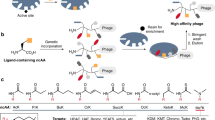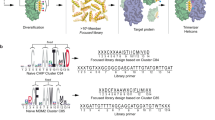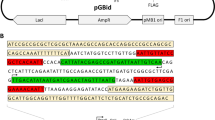Abstract
DNA-binding domains with predetermined sequence specificity are engineered by selection of zinc finger modules using phage display, allowing the construction of customized transcription factors. Despite remarkable progress in this field, the available protein-engineering methods are deficient in many respects, thus hampering the applicability of the technique. Here we present a rapid and convenient method that can be used to design zinc finger proteins against a variety of DNA-binding sites. This is based on a pair of pre-made zinc finger phage-display libraries, which are used in parallel to select two DNA-binding domains each of which recognizes given 5 base pair sequences, and whose products are recombined to produce a single protein that recognizes a composite (9 base pair) site of predefined sequence. Engineering using this system can be completed in less than two weeks and yields proteins that bind sequence-specifically to DNA with Kd values in the nanomolar range. To illustrate the technique, we have selected seven different proteins to bind various regions of the human immunodeficiency virus 1 (HIV-1) promoter.
This is a preview of subscription content, access via your institution
Access options
Subscribe to this journal
Receive 12 print issues and online access
$209.00 per year
only $17.42 per issue
Buy this article
- Purchase on Springer Link
- Instant access to full article PDF
Prices may be subject to local taxes which are calculated during checkout






Similar content being viewed by others
References
Choo, Y., Sanchez-Garcia, I. & Klug, A. In vivo repression by a site-specific DNA-binding protein designed against an oncogenic sequence. Nature 372, 642–645 (1994).
Greisman, H.A. & Pabo, C.O. A general strategy for selecting high-affinity zinc finger proteins for diverse DNA target sites. Science 275, 657–661 (1997).
Klug, A. & Rhodes, D. 'Zinc fingers': a novel protein motif for nucleic acid recognition. Trends Biochem. Sci. 12, 464–469 (1987).
Choo, Y. & Klug, A. Designing DNA-binding proteins on the surface of filamentous phage. Curr. Opin. Biotechnol. 6, 431–436 (1995).
Miller, J., McLachlan, A.D. & Klug, A. Repetitive zinc-binding domains in the protein transcription factor IIIA from Xenopus oocytes. EMBO J. 4, 1609–1614 (1985).
Pavletich, N.P. & Pabo, C.O. Zinc finger–DNA recognition: crystal structure of a Zif268–DNA complex at 2.1 Å. Science 252, 809–817 (1991).
Rebar, E.J. & Pabo, C.O. Zinc finger phage: affinity selection of fingers with new DNA-binding specificities. Science 263, 671–673 (1994).
Jamieson, A.C., Kim, S.-H. & Wells, J.A. In vitro selection of zinc fingers with altered DNA-binding specificity. Biochemistry 33, 5689–5695 (1994).
Choo, Y. & Klug, A. Toward a code for the interactions of zinc fingers with DNA: selection of randomised zinc fingers displayed on phage. Proc. Natl. Acad. Sci. USA 91, 11163–11167 (1994).
Wu, H., Yang, W.-P. & Barbas, C. F. Building zinc fingers by selection: toward a therapeutic application. Proc. Natl. Acad. Sci. USA 92, 344–348 (1995).
Isalan, M., Klug, A. & Choo, Y. Comprehensive DNA recognition through concerted interactions from adjacent zinc fingers. Biochemistry 37, 12026–12033 (1998).
Choo, Y. Recognition of DNA methylation by zinc fingers. Nat. Struct. Biol. 5, 264–265 (1998).
Segal, D.J., Dreier, B., Beerli, R.R. & Barbas, C.F. Toward controlling gene expression at will: selection and design of zinc finger domains recognising each of the 5′-GNN-3′ DNA target sequences. Proc. Natl. Acad. Sci. USA 96, 2758–2763 (1999).
Dreier, B., Segal, D.J. & Barbas, C.F. Insights into the molecular recognition of the 5′-GNN-3′ family of DNA sequences by zinc finger domains. J. Mol. Biol. 303, 489–502 (2000).
Isalan, M. & Choo, Y. Engineered zinc finger proteins that recognise DNA modification by HaeIII and HhaI methyltransferase enzymes. J. Mol. Biol. 295, 471–477 (2000).
Beerli, R.R., Dreier, B. & Barbas, C.F. Positive and negative regulation of endogenous genes by designed transcription factors. Proc. Natl. Acad. Sci. USA 97, 1495–1500 (2000).
Choo, Y. & Isalan, M.D. Advances in zinc finger engineering. Curr. Opin. Struct. Biol. 10, 411–416 (2000).
Wolfe, S.A., Greisman, H.A., Ramm, E.I. & Pabo, C.O. Analysis of zinc fingers optimised via phage display: evaluating the utility of a recognition code. J. Mol. Biol. 285, 1917–1934 (1999).
Isalan, M., Choo, Y. & Klug, A. Synergy between adjacent zinc fingers in sequence-specific DNA recognition. Proc. Natl. Acad. Sci. USA 94, 5617–5621 (1997).
Christy, B.A., Lau, L.F. & Nathans, D. A gene activated in mouse 3T3 cells by serum growth factors encodes a protein with “zinc finger” sequences. Proc. Natl. Acad. Sci. USA 85, 7857–7861 (1988).
Choo, Y. & Klug, A. Selection of DNA binding sites for zinc fingers using rationally randomised DNA reveals coded interactions. Proc. Natl. Acad. Sci. USA 91, 11168–11172 (1994).
Thiesen, H.J. From repression domains to designer zinc finger proteins: a novel strategy of cellular immunisation against HIV. Gene Expr. 5, 229–243 (1996).
Wu, H., Yang, W.-P. & Barbas, C.F. Building zinc fingers by selection: toward a therapeutic application. Proc. Natl. Acad. Sci. USA 92, 344–348 (1995).
Liu, Q., Segal, D.J., Ghiara, J.B. & Barbas, C.F. Design of polydactyl zinc-finger proteins for unique addressing within complex genomes. Proc. Natl. Acad. Sci. USA 94, 5525–5530 (1997).
Kim, J.S. & Pabo, C.O. Getting a handhold on DNA: design of poly-zinc finger proteins with femtomolar dissociation constants. Proc. Natl. Acad. Sci. USA 95, 2812–2817 (1998).
Moore, M., Choo, Y. & Klug, A. Design of polyzinc finger peptides with structured linkers. Proc. Natl. Acad. Sci. USA 98, 1432–1436 (2001).
Moore, M., Klug, A. & Choo, Y. Improved DNA-binding specificity from polyzinc finger peptides by using strings of two-finger units. Proc. Natl. Acad. Sci. USA 98, 1437–1441 (2001).
Choo, Y. & Klug, A. Physical basis of a protein–DNA recognition code. Curr. Opin. Struct. Biol. 7, 117–125 (1997).
Kang, J.S. & Kim, J.S. Zinc finger proteins as designer transcription factors. J. Biol. Chem. 275, 8742–8748 (2000).
Liu, P.Q. et al. Regulation of an endogenous locus using a panel of designed zinc finger proteins targeted to accessible chromatin regions. Activation of vascular endothelial growth factor A. J. Biol. Chem. 276, 11323–11334 (2001).
Zhang, L. et al. Synthetic zinc finger transcription factor action at an endogenous chromosomal site. Activation of the human erythropoietin gene. J. Biol. Chem. 275, 33850–33860 (2000).
Elrod-Erickson, M., Rould, M.A., Nekludova, L. & Pabo, C.O. Zif268 protein–DNA complex refined at 1.6A: a model system for understanding zinc finger interactions. Structure 4, 1171–1180 (1996).
Acknowledgements
This work was supported by the Medical Research Council, UK..
Author information
Authors and Affiliations
Corresponding author
Rights and permissions
About this article
Cite this article
Isalan, M., Klug, A. & Choo, Y. A rapid, generally applicable method to engineer zinc fingers illustrated by targeting the HIV-1 promoter. Nat Biotechnol 19, 656–660 (2001). https://doi.org/10.1038/90264
Received:
Accepted:
Issue Date:
DOI: https://doi.org/10.1038/90264
This article is cited by
-
A universal deep-learning model for zinc finger design enables transcription factor reprogramming
Nature Biotechnology (2023)
-
Intracellular directed evolution of proteins from combinatorial libraries based on conditional phage replication
Nature Protocols (2017)
-
An ensemble micro neural network approach for elucidating interactions between zinc finger proteins and their target DNA
BMC Genomics (2016)
-
Deimmunization for gene therapy: host matching of synthetic zinc finger constructs enables long-term mutant Huntingtin repression in mice
Molecular Neurodegeneration (2016)
-
Exploiting the recognition code for elucidating the mechanism of zinc finger protein-DNA interactions
BMC Genomics (2016)



